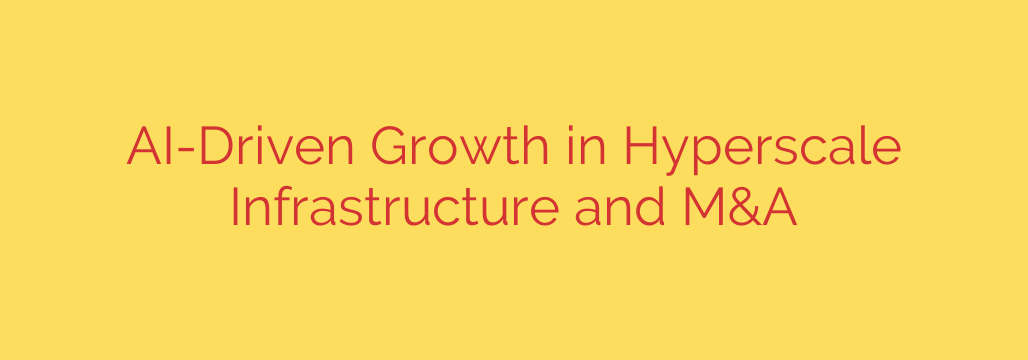
The AI Revolution: How Artificial Intelligence is Fueling a Data Center M&A Boom
From generating insightful text to creating stunning images, generative AI has captured the world’s imagination. But behind every AI-powered query lies a massive, power-hungry engine: the hyperscale data center. The explosive growth of artificial intelligence is creating an unprecedented demand for digital infrastructure, triggering a surge in mergers and acquisitions (M&A) as companies race to secure the foundation for the next technological era.
This isn’t just about adding more servers. The infrastructure required for AI is fundamentally different, driving a strategic shift in how data centers are built, acquired, and operated.
Why AI Demands a New Breed of Infrastructure
Traditional cloud computing and data storage have relatively predictable power needs. AI workloads, especially for training large language models (LLMs), are a different beast altogether. They rely on thousands of specialized Graphics Processing Units (GPUs) working in concert, leading to unique and immense challenges.
The key differentiators are:
- Massive Power Consumption: An AI-focused data center rack can consume 50-100 kW or more, compared to the 7-10 kW of a typical rack. This incredible power density means facilities require direct access to substation-level power, a resource that is both scarce and takes years to secure.
- Specialized Cooling: All that power generates an immense amount of heat. Traditional air-cooling methods are often insufficient, pushing the industry toward advanced liquid cooling solutions. This technology is more efficient but also more complex and expensive to implement, requiring specialized facility designs.
- High-Density Requirements: To minimize latency and maximize performance, thousands of GPUs must be packed closely together. This requires a physical infrastructure that can support the weight, power, and cooling for these high-density clusters.
Building a facility that meets these specifications from the ground up is a monumental task, often taking three to six years due to permitting, land acquisition, and construction. In the fast-moving world of AI, that timeline is an eternity.
The M&A Gold Rush: Why Buying Is the New Building
Given the long lead times and intense competition, many companies are concluding that it’s faster and more strategic to buy than to build. This has ignited a hot M&A market, with tech giants, private equity firms, and infrastructure funds all vying for control of valuable data center assets.
The primary driver behind this M&A activity is speed to market. Acquiring an existing data center provider or a portfolio of facilities allows a company to immediately gain capacity and a foothold in key markets.
Investors are targeting companies that possess the most valuable and scarce resources in this new landscape:
- Land with Secured Power: A plot of land is only valuable if it comes with a contract for significant power delivery from a utility. These “powered shells” or land banks are prime acquisition targets.
- Existing Infrastructure: Acquiring operational data centers, even if they need retrofitting for AI, provides a massive head start over new construction projects.
- Skilled Teams: Data center operations require a specialized skill set. An acquisition often includes retaining an experienced team capable of managing these complex facilities.
This wave of consolidation means that established data center operators and real estate investment trusts (REITs) are becoming increasingly valuable, as they control the very infrastructure that the AI revolution is built upon.
Actionable Advice: Navigating the AI Infrastructure Boom
For businesses and investors, the current market presents both opportunities and significant challenges. Success in this environment requires a forward-thinking strategy.
Prioritize Power Availability: When evaluating data center investments or partners, the single most important factor is the site’s power capacity and the timeline for its availability. Verify power contracts and grid stability before committing to any project. A facility without adequate power is effectively useless for serious AI workloads.
Plan for Future Cooling Needs: Don’t just plan for today’s technology. Assume that future AI hardware will be even more power-dense. Facilities designed with the flexibility to incorporate advanced liquid cooling will have a significant competitive advantage and a longer lifespan.
Secure Your Supply Chain: The demand for specialized hardware like GPUs far outstrips supply. Building strong relationships with hardware vendors is critical to ensuring you can equip your facilities. Delays in hardware delivery can render a newly built or acquired data center idle.
The synergy between AI and data center infrastructure is creating a new class of digital real estate. As the demand for artificial intelligence continues to accelerate, the M&A activity in the hyperscale data center sector is not just a trend—it’s a strategic necessity for companies aiming to lead the future of technology. The race is on, and those who secure the right infrastructure today will be the power brokers of tomorrow.
Source: https://datacenterpost.com/ai-surge-fuels-explosive-growth-in-hyperscale-infrastructure-and-ma-activity/








